Governance and Sustainability: A Deep Dive Business Report
VerifiedAdded on 2020/05/16
|22
|5454
|49
Report
AI Summary
This report provides a comprehensive analysis of governance and sustainability, beginning with an overview of the green economy concept and its importance in promoting societal wealth and well-being. It then delves into the challenges faced in advancing sustainability initiatives, particularly in the context of South Africa. The report explores the Triple Bottom Line approach, emphasizing its role in assessing a business's environmental, economic, and social impact. Furthermore, it examines the Environmental, Social, and Governance (ESG) triad, detailing its standards for socially conscious investment and the relationship between corporate governance and sustainability. The report also touches upon corporate governance and ethics, the hallmarks of an effective integrity organizational strategy, and Carroll’s four-part definition of Corporate Social Responsibility (CSR). The report concludes with a reference list of all the sources used.
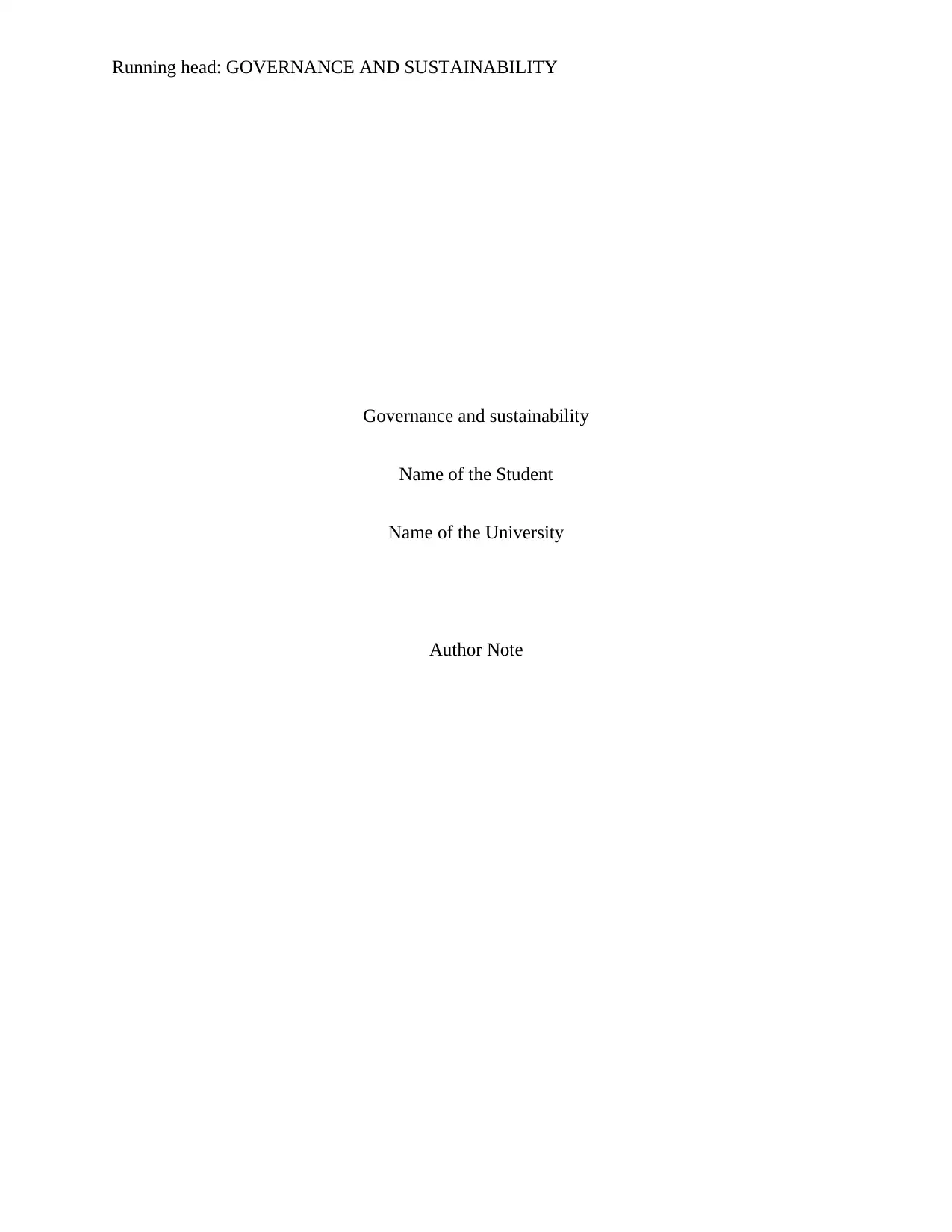
Running head: GOVERNANCE AND SUSTAINABILITY
Governance and sustainability
Name of the Student
Name of the University
Author Note
Governance and sustainability
Name of the Student
Name of the University
Author Note
Paraphrase This Document
Need a fresh take? Get an instant paraphrase of this document with our AI Paraphraser
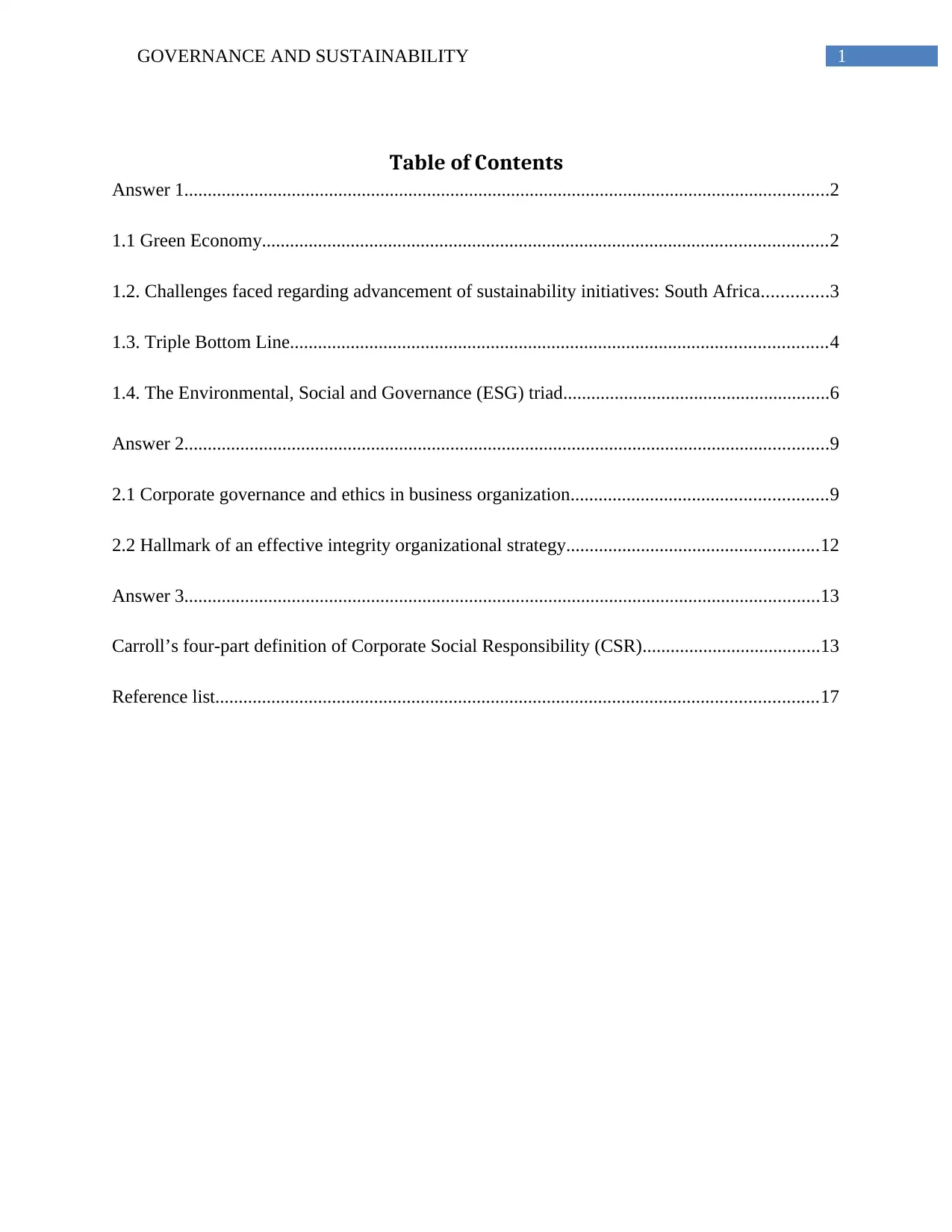
1GOVERNANCE AND SUSTAINABILITY
Table of Contents
Answer 1..........................................................................................................................................2
1.1 Green Economy.........................................................................................................................2
1.2. Challenges faced regarding advancement of sustainability initiatives: South Africa..............3
1.3. Triple Bottom Line...................................................................................................................4
1.4. The Environmental, Social and Governance (ESG) triad.........................................................6
Answer 2..........................................................................................................................................9
2.1 Corporate governance and ethics in business organization.......................................................9
2.2 Hallmark of an effective integrity organizational strategy......................................................12
Answer 3........................................................................................................................................13
Carroll’s four-part definition of Corporate Social Responsibility (CSR)......................................13
Reference list.................................................................................................................................17
Table of Contents
Answer 1..........................................................................................................................................2
1.1 Green Economy.........................................................................................................................2
1.2. Challenges faced regarding advancement of sustainability initiatives: South Africa..............3
1.3. Triple Bottom Line...................................................................................................................4
1.4. The Environmental, Social and Governance (ESG) triad.........................................................6
Answer 2..........................................................................................................................................9
2.1 Corporate governance and ethics in business organization.......................................................9
2.2 Hallmark of an effective integrity organizational strategy......................................................12
Answer 3........................................................................................................................................13
Carroll’s four-part definition of Corporate Social Responsibility (CSR)......................................13
Reference list.................................................................................................................................17
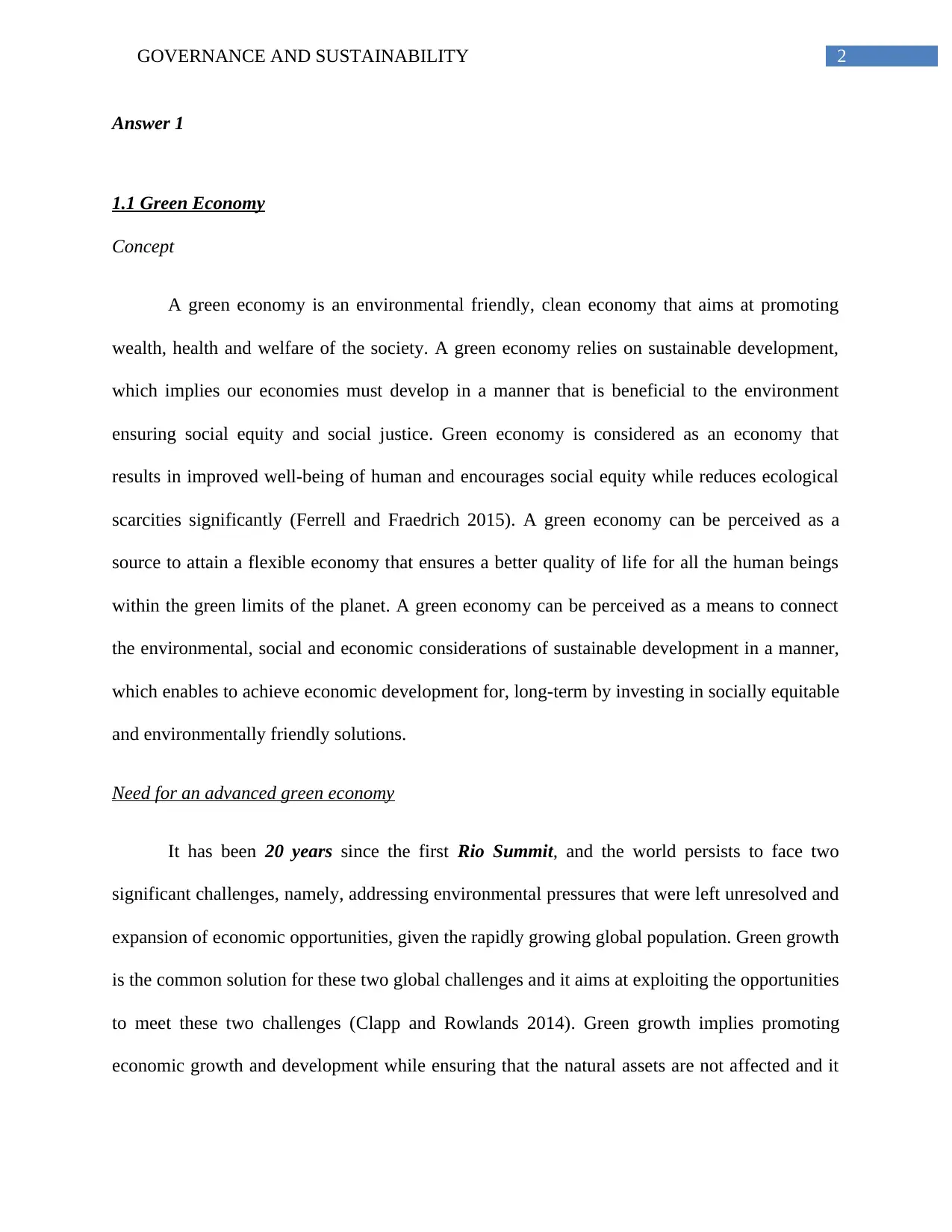
2GOVERNANCE AND SUSTAINABILITY
Answer 1
1.1 Green Economy
Concept
A green economy is an environmental friendly, clean economy that aims at promoting
wealth, health and welfare of the society. A green economy relies on sustainable development,
which implies our economies must develop in a manner that is beneficial to the environment
ensuring social equity and social justice. Green economy is considered as an economy that
results in improved well-being of human and encourages social equity while reduces ecological
scarcities significantly (Ferrell and Fraedrich 2015). A green economy can be perceived as a
source to attain a flexible economy that ensures a better quality of life for all the human beings
within the green limits of the planet. A green economy can be perceived as a means to connect
the environmental, social and economic considerations of sustainable development in a manner,
which enables to achieve economic development for, long-term by investing in socially equitable
and environmentally friendly solutions.
Need for an advanced green economy
It has been 20 years since the first Rio Summit, and the world persists to face two
significant challenges, namely, addressing environmental pressures that were left unresolved and
expansion of economic opportunities, given the rapidly growing global population. Green growth
is the common solution for these two global challenges and it aims at exploiting the opportunities
to meet these two challenges (Clapp and Rowlands 2014). Green growth implies promoting
economic growth and development while ensuring that the natural assets are not affected and it
Answer 1
1.1 Green Economy
Concept
A green economy is an environmental friendly, clean economy that aims at promoting
wealth, health and welfare of the society. A green economy relies on sustainable development,
which implies our economies must develop in a manner that is beneficial to the environment
ensuring social equity and social justice. Green economy is considered as an economy that
results in improved well-being of human and encourages social equity while reduces ecological
scarcities significantly (Ferrell and Fraedrich 2015). A green economy can be perceived as a
source to attain a flexible economy that ensures a better quality of life for all the human beings
within the green limits of the planet. A green economy can be perceived as a means to connect
the environmental, social and economic considerations of sustainable development in a manner,
which enables to achieve economic development for, long-term by investing in socially equitable
and environmentally friendly solutions.
Need for an advanced green economy
It has been 20 years since the first Rio Summit, and the world persists to face two
significant challenges, namely, addressing environmental pressures that were left unresolved and
expansion of economic opportunities, given the rapidly growing global population. Green growth
is the common solution for these two global challenges and it aims at exploiting the opportunities
to meet these two challenges (Clapp and Rowlands 2014). Green growth implies promoting
economic growth and development while ensuring that the natural assets are not affected and it
⊘ This is a preview!⊘
Do you want full access?
Subscribe today to unlock all pages.

Trusted by 1+ million students worldwide
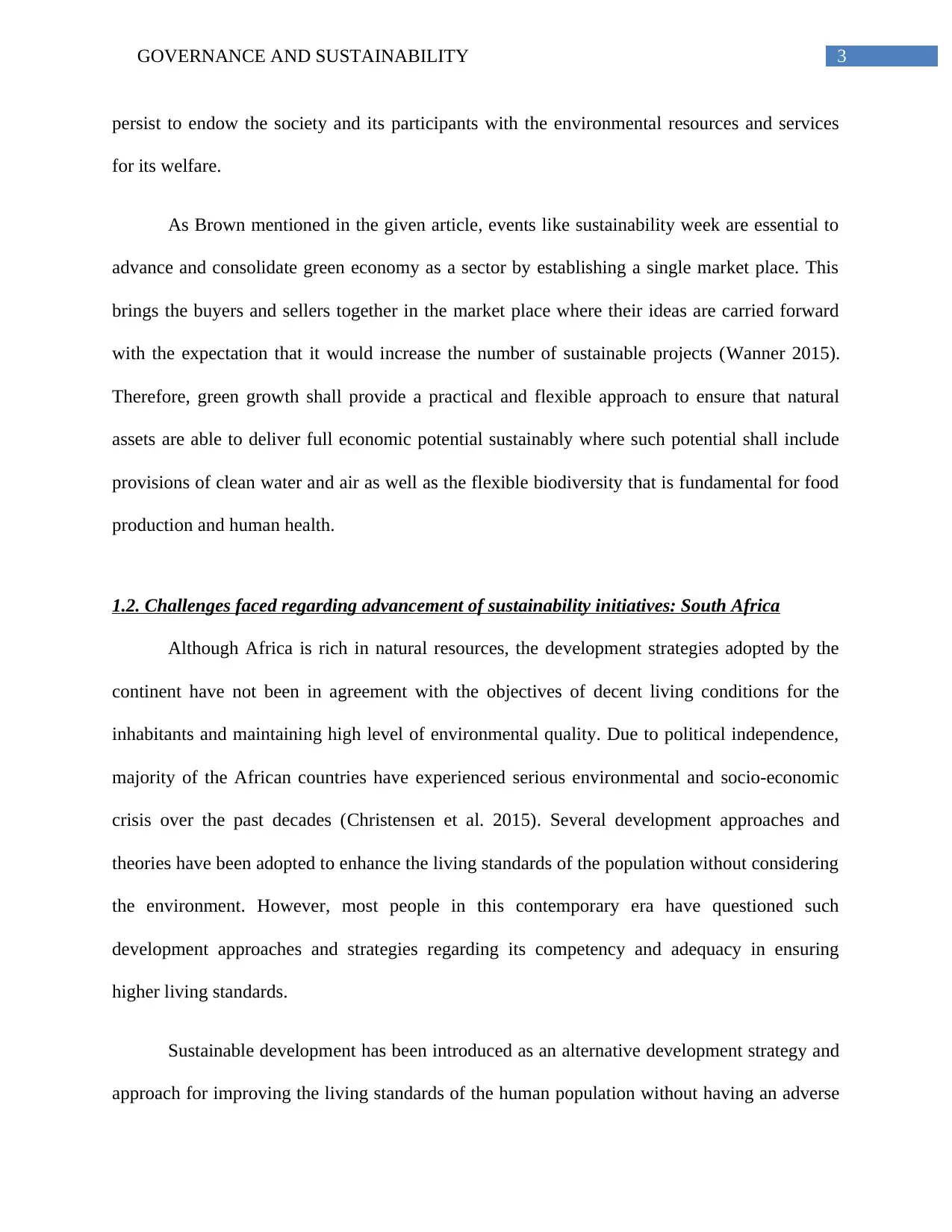
3GOVERNANCE AND SUSTAINABILITY
persist to endow the society and its participants with the environmental resources and services
for its welfare.
As Brown mentioned in the given article, events like sustainability week are essential to
advance and consolidate green economy as a sector by establishing a single market place. This
brings the buyers and sellers together in the market place where their ideas are carried forward
with the expectation that it would increase the number of sustainable projects (Wanner 2015).
Therefore, green growth shall provide a practical and flexible approach to ensure that natural
assets are able to deliver full economic potential sustainably where such potential shall include
provisions of clean water and air as well as the flexible biodiversity that is fundamental for food
production and human health.
1.2. Challenges faced regarding advancement of sustainability initiatives: South Africa
Although Africa is rich in natural resources, the development strategies adopted by the
continent have not been in agreement with the objectives of decent living conditions for the
inhabitants and maintaining high level of environmental quality. Due to political independence,
majority of the African countries have experienced serious environmental and socio-economic
crisis over the past decades (Christensen et al. 2015). Several development approaches and
theories have been adopted to enhance the living standards of the population without considering
the environment. However, most people in this contemporary era have questioned such
development approaches and strategies regarding its competency and adequacy in ensuring
higher living standards.
Sustainable development has been introduced as an alternative development strategy and
approach for improving the living standards of the human population without having an adverse
persist to endow the society and its participants with the environmental resources and services
for its welfare.
As Brown mentioned in the given article, events like sustainability week are essential to
advance and consolidate green economy as a sector by establishing a single market place. This
brings the buyers and sellers together in the market place where their ideas are carried forward
with the expectation that it would increase the number of sustainable projects (Wanner 2015).
Therefore, green growth shall provide a practical and flexible approach to ensure that natural
assets are able to deliver full economic potential sustainably where such potential shall include
provisions of clean water and air as well as the flexible biodiversity that is fundamental for food
production and human health.
1.2. Challenges faced regarding advancement of sustainability initiatives: South Africa
Although Africa is rich in natural resources, the development strategies adopted by the
continent have not been in agreement with the objectives of decent living conditions for the
inhabitants and maintaining high level of environmental quality. Due to political independence,
majority of the African countries have experienced serious environmental and socio-economic
crisis over the past decades (Christensen et al. 2015). Several development approaches and
theories have been adopted to enhance the living standards of the population without considering
the environment. However, most people in this contemporary era have questioned such
development approaches and strategies regarding its competency and adequacy in ensuring
higher living standards.
Sustainable development has been introduced as an alternative development strategy and
approach for improving the living standards of the human population without having an adverse
Paraphrase This Document
Need a fresh take? Get an instant paraphrase of this document with our AI Paraphraser
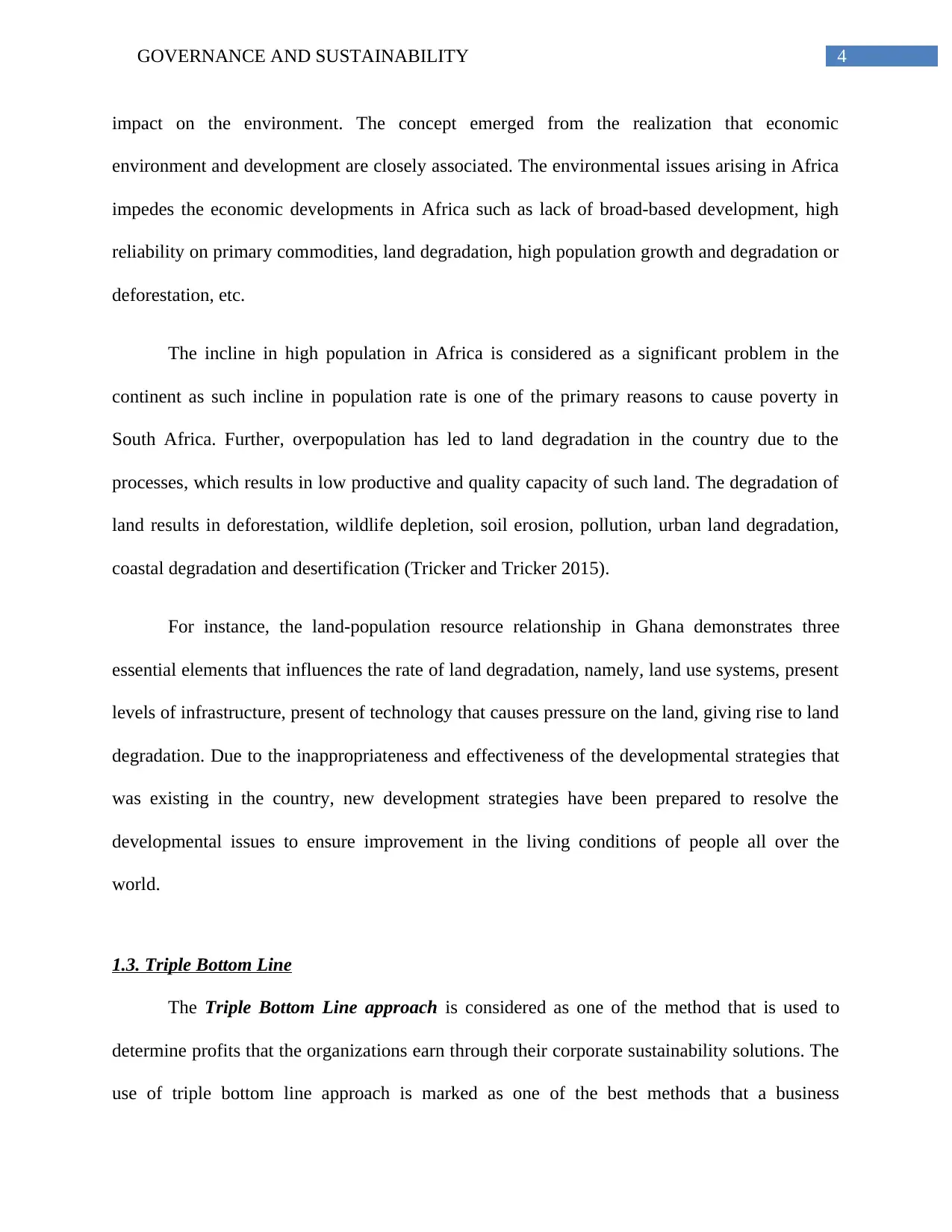
4GOVERNANCE AND SUSTAINABILITY
impact on the environment. The concept emerged from the realization that economic
environment and development are closely associated. The environmental issues arising in Africa
impedes the economic developments in Africa such as lack of broad-based development, high
reliability on primary commodities, land degradation, high population growth and degradation or
deforestation, etc.
The incline in high population in Africa is considered as a significant problem in the
continent as such incline in population rate is one of the primary reasons to cause poverty in
South Africa. Further, overpopulation has led to land degradation in the country due to the
processes, which results in low productive and quality capacity of such land. The degradation of
land results in deforestation, wildlife depletion, soil erosion, pollution, urban land degradation,
coastal degradation and desertification (Tricker and Tricker 2015).
For instance, the land-population resource relationship in Ghana demonstrates three
essential elements that influences the rate of land degradation, namely, land use systems, present
levels of infrastructure, present of technology that causes pressure on the land, giving rise to land
degradation. Due to the inappropriateness and effectiveness of the developmental strategies that
was existing in the country, new development strategies have been prepared to resolve the
developmental issues to ensure improvement in the living conditions of people all over the
world.
1.3. Triple Bottom Line
The Triple Bottom Line approach is considered as one of the method that is used to
determine profits that the organizations earn through their corporate sustainability solutions. The
use of triple bottom line approach is marked as one of the best methods that a business
impact on the environment. The concept emerged from the realization that economic
environment and development are closely associated. The environmental issues arising in Africa
impedes the economic developments in Africa such as lack of broad-based development, high
reliability on primary commodities, land degradation, high population growth and degradation or
deforestation, etc.
The incline in high population in Africa is considered as a significant problem in the
continent as such incline in population rate is one of the primary reasons to cause poverty in
South Africa. Further, overpopulation has led to land degradation in the country due to the
processes, which results in low productive and quality capacity of such land. The degradation of
land results in deforestation, wildlife depletion, soil erosion, pollution, urban land degradation,
coastal degradation and desertification (Tricker and Tricker 2015).
For instance, the land-population resource relationship in Ghana demonstrates three
essential elements that influences the rate of land degradation, namely, land use systems, present
levels of infrastructure, present of technology that causes pressure on the land, giving rise to land
degradation. Due to the inappropriateness and effectiveness of the developmental strategies that
was existing in the country, new development strategies have been prepared to resolve the
developmental issues to ensure improvement in the living conditions of people all over the
world.
1.3. Triple Bottom Line
The Triple Bottom Line approach is considered as one of the method that is used to
determine profits that the organizations earn through their corporate sustainability solutions. The
use of triple bottom line approach is marked as one of the best methods that a business
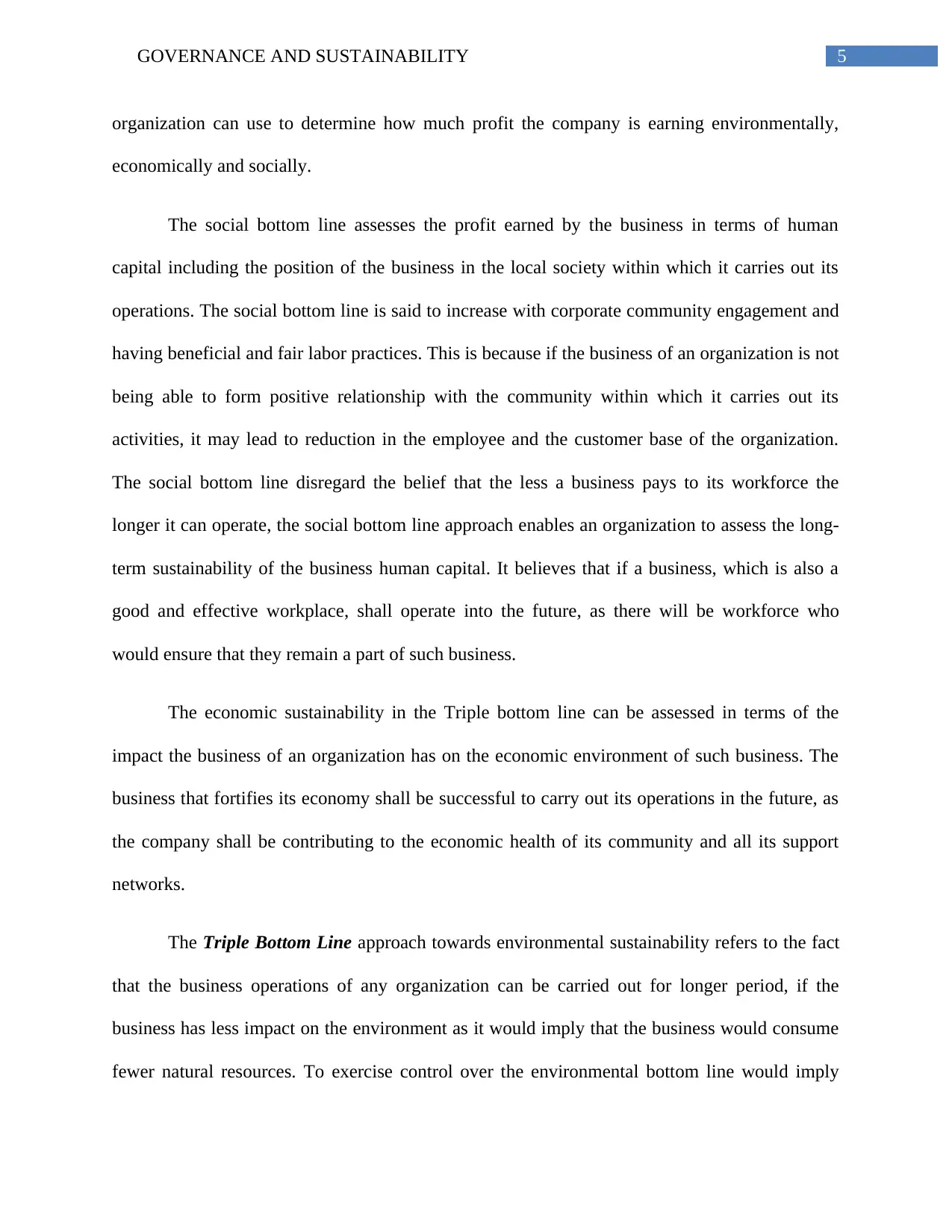
5GOVERNANCE AND SUSTAINABILITY
organization can use to determine how much profit the company is earning environmentally,
economically and socially.
The social bottom line assesses the profit earned by the business in terms of human
capital including the position of the business in the local society within which it carries out its
operations. The social bottom line is said to increase with corporate community engagement and
having beneficial and fair labor practices. This is because if the business of an organization is not
being able to form positive relationship with the community within which it carries out its
activities, it may lead to reduction in the employee and the customer base of the organization.
The social bottom line disregard the belief that the less a business pays to its workforce the
longer it can operate, the social bottom line approach enables an organization to assess the long-
term sustainability of the business human capital. It believes that if a business, which is also a
good and effective workplace, shall operate into the future, as there will be workforce who
would ensure that they remain a part of such business.
The economic sustainability in the Triple bottom line can be assessed in terms of the
impact the business of an organization has on the economic environment of such business. The
business that fortifies its economy shall be successful to carry out its operations in the future, as
the company shall be contributing to the economic health of its community and all its support
networks.
The Triple Bottom Line approach towards environmental sustainability refers to the fact
that the business operations of any organization can be carried out for longer period, if the
business has less impact on the environment as it would imply that the business would consume
fewer natural resources. To exercise control over the environmental bottom line would imply
organization can use to determine how much profit the company is earning environmentally,
economically and socially.
The social bottom line assesses the profit earned by the business in terms of human
capital including the position of the business in the local society within which it carries out its
operations. The social bottom line is said to increase with corporate community engagement and
having beneficial and fair labor practices. This is because if the business of an organization is not
being able to form positive relationship with the community within which it carries out its
activities, it may lead to reduction in the employee and the customer base of the organization.
The social bottom line disregard the belief that the less a business pays to its workforce the
longer it can operate, the social bottom line approach enables an organization to assess the long-
term sustainability of the business human capital. It believes that if a business, which is also a
good and effective workplace, shall operate into the future, as there will be workforce who
would ensure that they remain a part of such business.
The economic sustainability in the Triple bottom line can be assessed in terms of the
impact the business of an organization has on the economic environment of such business. The
business that fortifies its economy shall be successful to carry out its operations in the future, as
the company shall be contributing to the economic health of its community and all its support
networks.
The Triple Bottom Line approach towards environmental sustainability refers to the fact
that the business operations of any organization can be carried out for longer period, if the
business has less impact on the environment as it would imply that the business would consume
fewer natural resources. To exercise control over the environmental bottom line would imply
⊘ This is a preview!⊘
Do you want full access?
Subscribe today to unlock all pages.

Trusted by 1+ million students worldwide
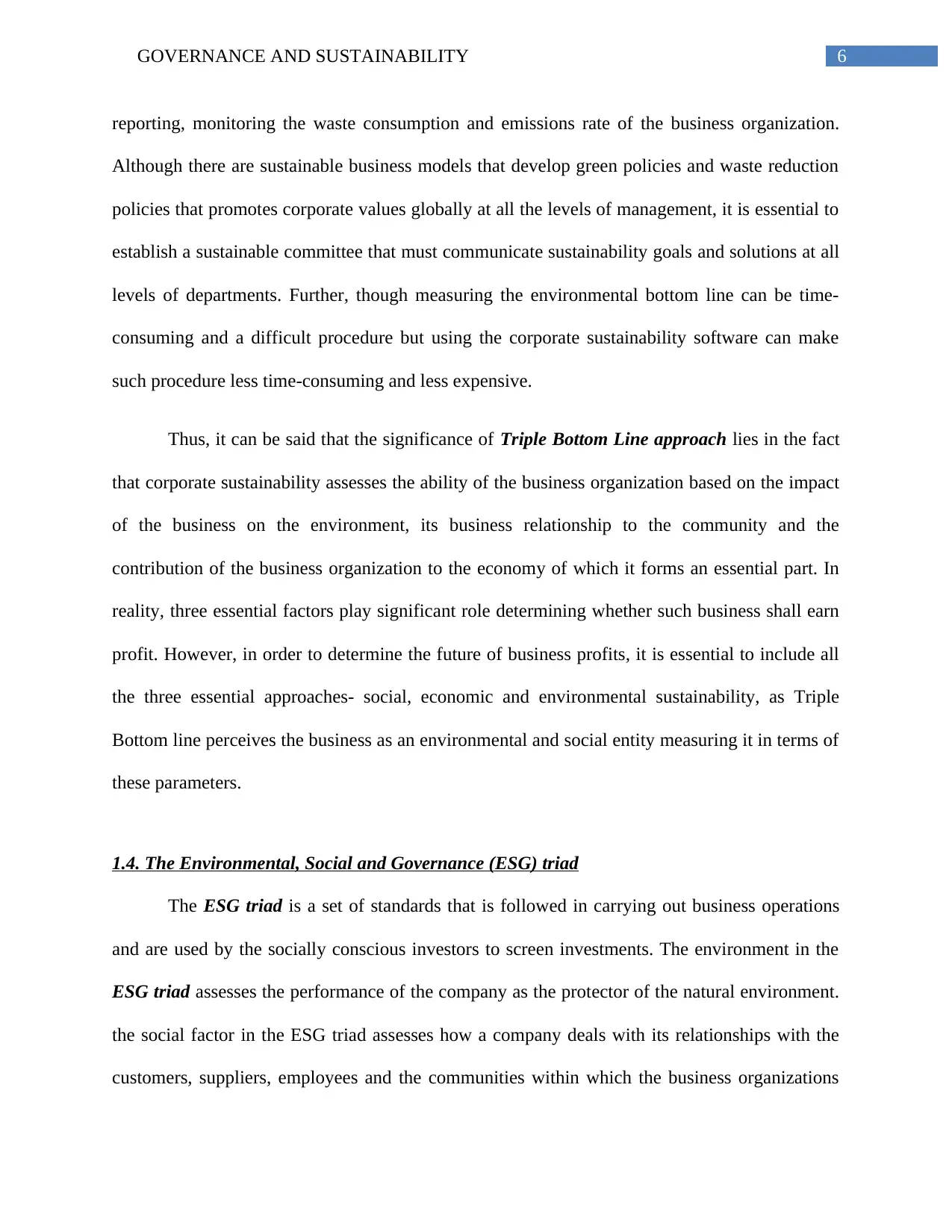
6GOVERNANCE AND SUSTAINABILITY
reporting, monitoring the waste consumption and emissions rate of the business organization.
Although there are sustainable business models that develop green policies and waste reduction
policies that promotes corporate values globally at all the levels of management, it is essential to
establish a sustainable committee that must communicate sustainability goals and solutions at all
levels of departments. Further, though measuring the environmental bottom line can be time-
consuming and a difficult procedure but using the corporate sustainability software can make
such procedure less time-consuming and less expensive.
Thus, it can be said that the significance of Triple Bottom Line approach lies in the fact
that corporate sustainability assesses the ability of the business organization based on the impact
of the business on the environment, its business relationship to the community and the
contribution of the business organization to the economy of which it forms an essential part. In
reality, three essential factors play significant role determining whether such business shall earn
profit. However, in order to determine the future of business profits, it is essential to include all
the three essential approaches- social, economic and environmental sustainability, as Triple
Bottom line perceives the business as an environmental and social entity measuring it in terms of
these parameters.
1.4. The Environmental, Social and Governance (ESG) triad
The ESG triad is a set of standards that is followed in carrying out business operations
and are used by the socially conscious investors to screen investments. The environment in the
ESG triad assesses the performance of the company as the protector of the natural environment.
the social factor in the ESG triad assesses how a company deals with its relationships with the
customers, suppliers, employees and the communities within which the business organizations
reporting, monitoring the waste consumption and emissions rate of the business organization.
Although there are sustainable business models that develop green policies and waste reduction
policies that promotes corporate values globally at all the levels of management, it is essential to
establish a sustainable committee that must communicate sustainability goals and solutions at all
levels of departments. Further, though measuring the environmental bottom line can be time-
consuming and a difficult procedure but using the corporate sustainability software can make
such procedure less time-consuming and less expensive.
Thus, it can be said that the significance of Triple Bottom Line approach lies in the fact
that corporate sustainability assesses the ability of the business organization based on the impact
of the business on the environment, its business relationship to the community and the
contribution of the business organization to the economy of which it forms an essential part. In
reality, three essential factors play significant role determining whether such business shall earn
profit. However, in order to determine the future of business profits, it is essential to include all
the three essential approaches- social, economic and environmental sustainability, as Triple
Bottom line perceives the business as an environmental and social entity measuring it in terms of
these parameters.
1.4. The Environmental, Social and Governance (ESG) triad
The ESG triad is a set of standards that is followed in carrying out business operations
and are used by the socially conscious investors to screen investments. The environment in the
ESG triad assesses the performance of the company as the protector of the natural environment.
the social factor in the ESG triad assesses how a company deals with its relationships with the
customers, suppliers, employees and the communities within which the business organizations
Paraphrase This Document
Need a fresh take? Get an instant paraphrase of this document with our AI Paraphraser
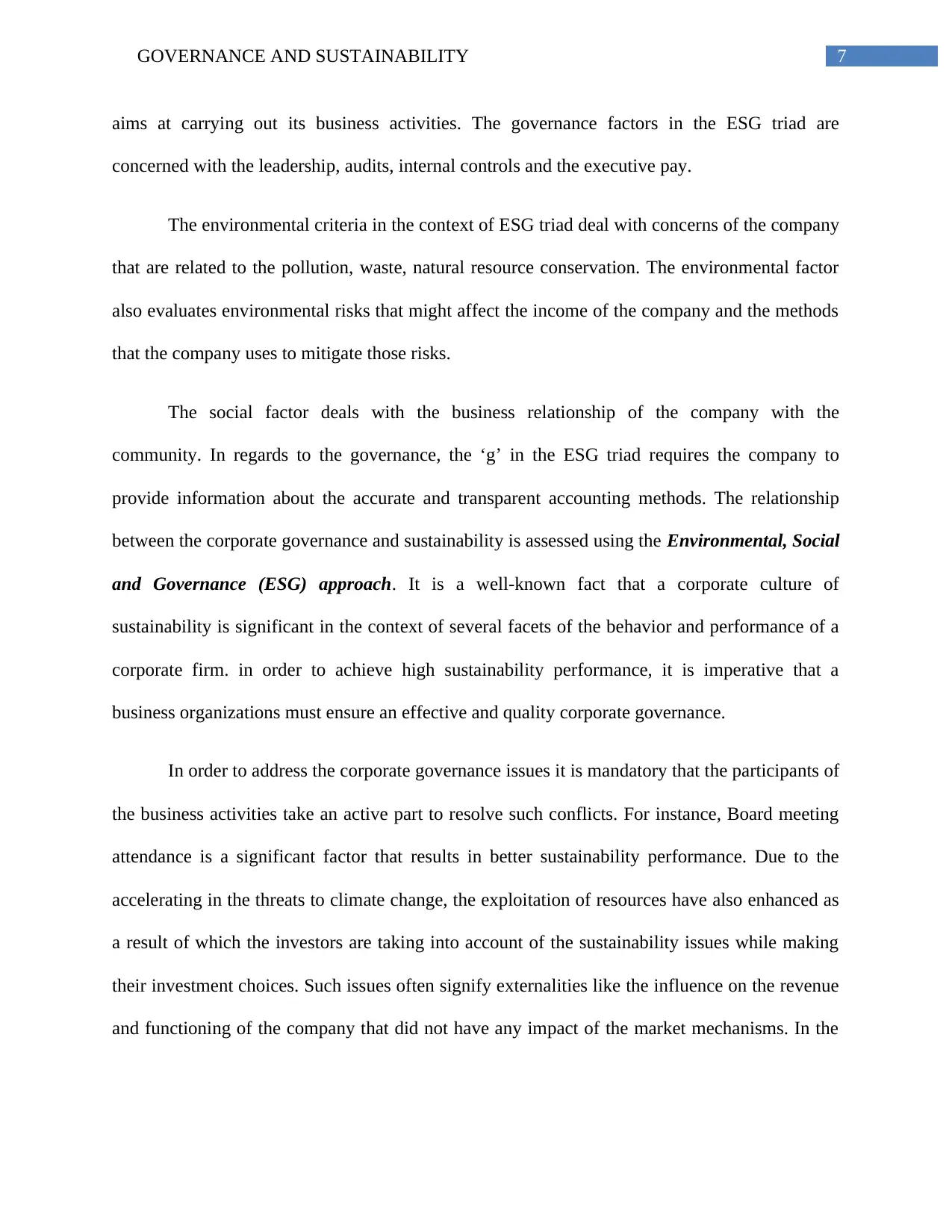
7GOVERNANCE AND SUSTAINABILITY
aims at carrying out its business activities. The governance factors in the ESG triad are
concerned with the leadership, audits, internal controls and the executive pay.
The environmental criteria in the context of ESG triad deal with concerns of the company
that are related to the pollution, waste, natural resource conservation. The environmental factor
also evaluates environmental risks that might affect the income of the company and the methods
that the company uses to mitigate those risks.
The social factor deals with the business relationship of the company with the
community. In regards to the governance, the ‘g’ in the ESG triad requires the company to
provide information about the accurate and transparent accounting methods. The relationship
between the corporate governance and sustainability is assessed using the Environmental, Social
and Governance (ESG) approach. It is a well-known fact that a corporate culture of
sustainability is significant in the context of several facets of the behavior and performance of a
corporate firm. in order to achieve high sustainability performance, it is imperative that a
business organizations must ensure an effective and quality corporate governance.
In order to address the corporate governance issues it is mandatory that the participants of
the business activities take an active part to resolve such conflicts. For instance, Board meeting
attendance is a significant factor that results in better sustainability performance. Due to the
accelerating in the threats to climate change, the exploitation of resources have also enhanced as
a result of which the investors are taking into account of the sustainability issues while making
their investment choices. Such issues often signify externalities like the influence on the revenue
and functioning of the company that did not have any impact of the market mechanisms. In the
aims at carrying out its business activities. The governance factors in the ESG triad are
concerned with the leadership, audits, internal controls and the executive pay.
The environmental criteria in the context of ESG triad deal with concerns of the company
that are related to the pollution, waste, natural resource conservation. The environmental factor
also evaluates environmental risks that might affect the income of the company and the methods
that the company uses to mitigate those risks.
The social factor deals with the business relationship of the company with the
community. In regards to the governance, the ‘g’ in the ESG triad requires the company to
provide information about the accurate and transparent accounting methods. The relationship
between the corporate governance and sustainability is assessed using the Environmental, Social
and Governance (ESG) approach. It is a well-known fact that a corporate culture of
sustainability is significant in the context of several facets of the behavior and performance of a
corporate firm. in order to achieve high sustainability performance, it is imperative that a
business organizations must ensure an effective and quality corporate governance.
In order to address the corporate governance issues it is mandatory that the participants of
the business activities take an active part to resolve such conflicts. For instance, Board meeting
attendance is a significant factor that results in better sustainability performance. Due to the
accelerating in the threats to climate change, the exploitation of resources have also enhanced as
a result of which the investors are taking into account of the sustainability issues while making
their investment choices. Such issues often signify externalities like the influence on the revenue
and functioning of the company that did not have any impact of the market mechanisms. In the
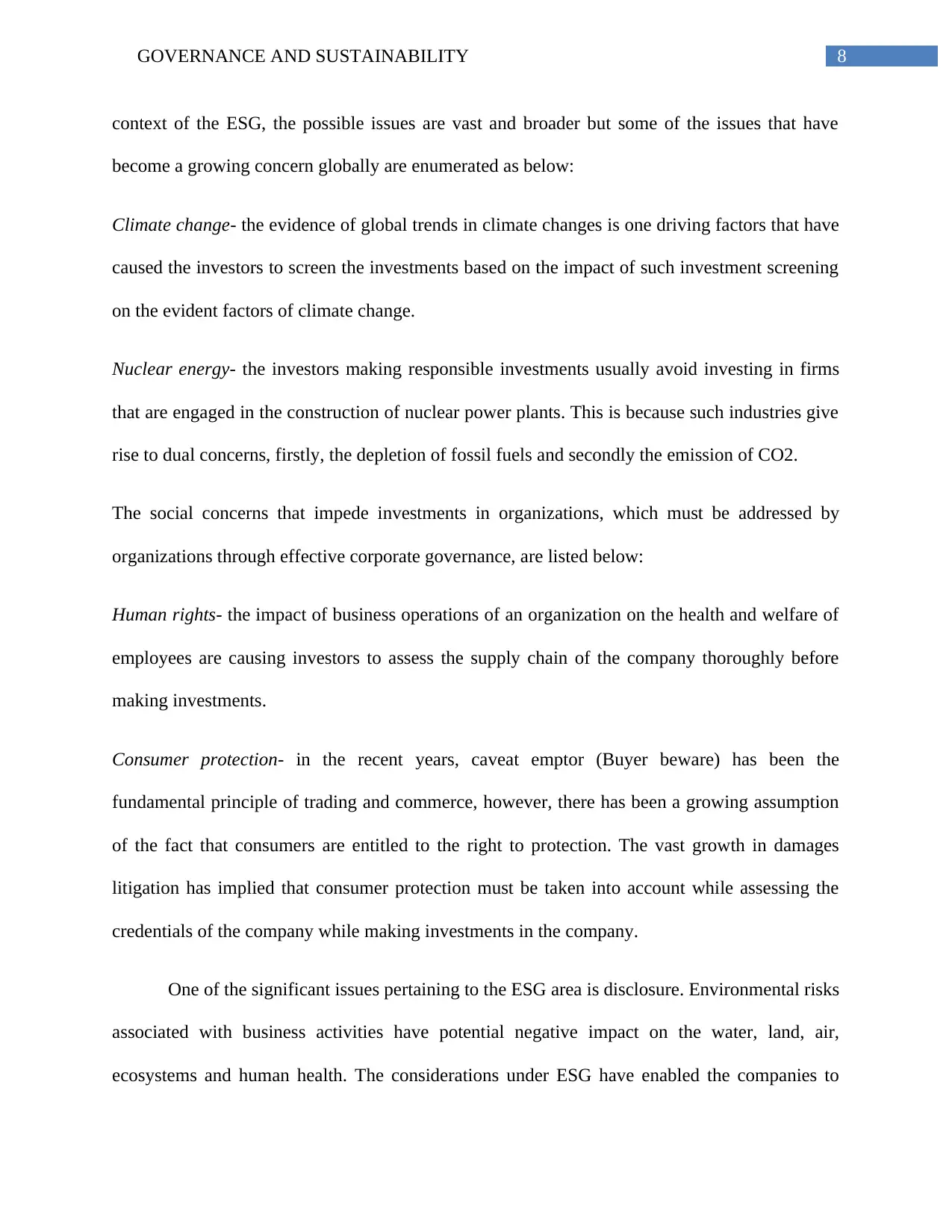
8GOVERNANCE AND SUSTAINABILITY
context of the ESG, the possible issues are vast and broader but some of the issues that have
become a growing concern globally are enumerated as below:
Climate change- the evidence of global trends in climate changes is one driving factors that have
caused the investors to screen the investments based on the impact of such investment screening
on the evident factors of climate change.
Nuclear energy- the investors making responsible investments usually avoid investing in firms
that are engaged in the construction of nuclear power plants. This is because such industries give
rise to dual concerns, firstly, the depletion of fossil fuels and secondly the emission of CO2.
The social concerns that impede investments in organizations, which must be addressed by
organizations through effective corporate governance, are listed below:
Human rights- the impact of business operations of an organization on the health and welfare of
employees are causing investors to assess the supply chain of the company thoroughly before
making investments.
Consumer protection- in the recent years, caveat emptor (Buyer beware) has been the
fundamental principle of trading and commerce, however, there has been a growing assumption
of the fact that consumers are entitled to the right to protection. The vast growth in damages
litigation has implied that consumer protection must be taken into account while assessing the
credentials of the company while making investments in the company.
One of the significant issues pertaining to the ESG area is disclosure. Environmental risks
associated with business activities have potential negative impact on the water, land, air,
ecosystems and human health. The considerations under ESG have enabled the companies to
context of the ESG, the possible issues are vast and broader but some of the issues that have
become a growing concern globally are enumerated as below:
Climate change- the evidence of global trends in climate changes is one driving factors that have
caused the investors to screen the investments based on the impact of such investment screening
on the evident factors of climate change.
Nuclear energy- the investors making responsible investments usually avoid investing in firms
that are engaged in the construction of nuclear power plants. This is because such industries give
rise to dual concerns, firstly, the depletion of fossil fuels and secondly the emission of CO2.
The social concerns that impede investments in organizations, which must be addressed by
organizations through effective corporate governance, are listed below:
Human rights- the impact of business operations of an organization on the health and welfare of
employees are causing investors to assess the supply chain of the company thoroughly before
making investments.
Consumer protection- in the recent years, caveat emptor (Buyer beware) has been the
fundamental principle of trading and commerce, however, there has been a growing assumption
of the fact that consumers are entitled to the right to protection. The vast growth in damages
litigation has implied that consumer protection must be taken into account while assessing the
credentials of the company while making investments in the company.
One of the significant issues pertaining to the ESG area is disclosure. Environmental risks
associated with business activities have potential negative impact on the water, land, air,
ecosystems and human health. The considerations under ESG have enabled the companies to
⊘ This is a preview!⊘
Do you want full access?
Subscribe today to unlock all pages.

Trusted by 1+ million students worldwide
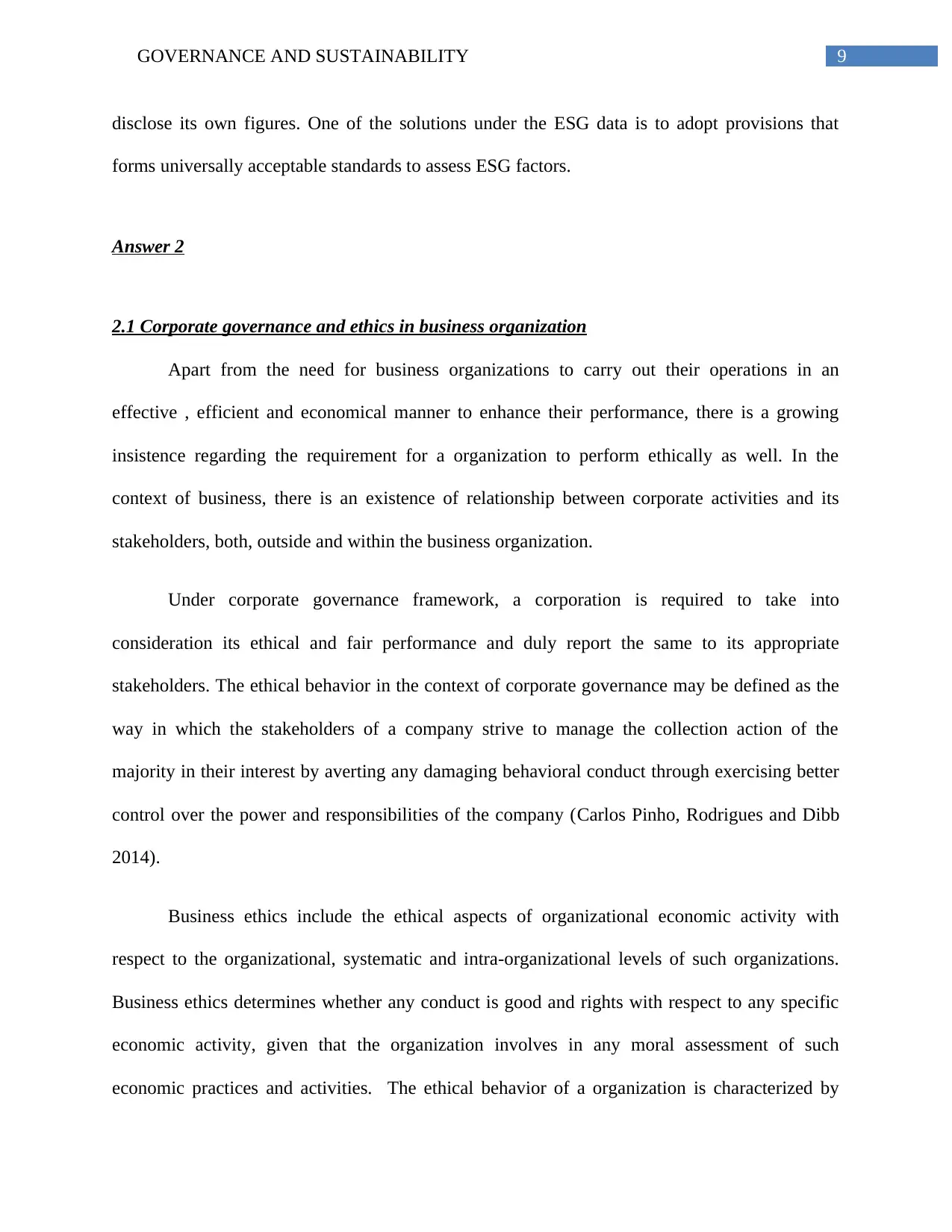
9GOVERNANCE AND SUSTAINABILITY
disclose its own figures. One of the solutions under the ESG data is to adopt provisions that
forms universally acceptable standards to assess ESG factors.
Answer 2
2.1 Corporate governance and ethics in business organization
Apart from the need for business organizations to carry out their operations in an
effective , efficient and economical manner to enhance their performance, there is a growing
insistence regarding the requirement for a organization to perform ethically as well. In the
context of business, there is an existence of relationship between corporate activities and its
stakeholders, both, outside and within the business organization.
Under corporate governance framework, a corporation is required to take into
consideration its ethical and fair performance and duly report the same to its appropriate
stakeholders. The ethical behavior in the context of corporate governance may be defined as the
way in which the stakeholders of a company strive to manage the collection action of the
majority in their interest by averting any damaging behavioral conduct through exercising better
control over the power and responsibilities of the company (Carlos Pinho, Rodrigues and Dibb
2014).
Business ethics include the ethical aspects of organizational economic activity with
respect to the organizational, systematic and intra-organizational levels of such organizations.
Business ethics determines whether any conduct is good and rights with respect to any specific
economic activity, given that the organization involves in any moral assessment of such
economic practices and activities. The ethical behavior of a organization is characterized by
disclose its own figures. One of the solutions under the ESG data is to adopt provisions that
forms universally acceptable standards to assess ESG factors.
Answer 2
2.1 Corporate governance and ethics in business organization
Apart from the need for business organizations to carry out their operations in an
effective , efficient and economical manner to enhance their performance, there is a growing
insistence regarding the requirement for a organization to perform ethically as well. In the
context of business, there is an existence of relationship between corporate activities and its
stakeholders, both, outside and within the business organization.
Under corporate governance framework, a corporation is required to take into
consideration its ethical and fair performance and duly report the same to its appropriate
stakeholders. The ethical behavior in the context of corporate governance may be defined as the
way in which the stakeholders of a company strive to manage the collection action of the
majority in their interest by averting any damaging behavioral conduct through exercising better
control over the power and responsibilities of the company (Carlos Pinho, Rodrigues and Dibb
2014).
Business ethics include the ethical aspects of organizational economic activity with
respect to the organizational, systematic and intra-organizational levels of such organizations.
Business ethics determines whether any conduct is good and rights with respect to any specific
economic activity, given that the organization involves in any moral assessment of such
economic practices and activities. The ethical behavior of a organization is characterized by
Paraphrase This Document
Need a fresh take? Get an instant paraphrase of this document with our AI Paraphraser
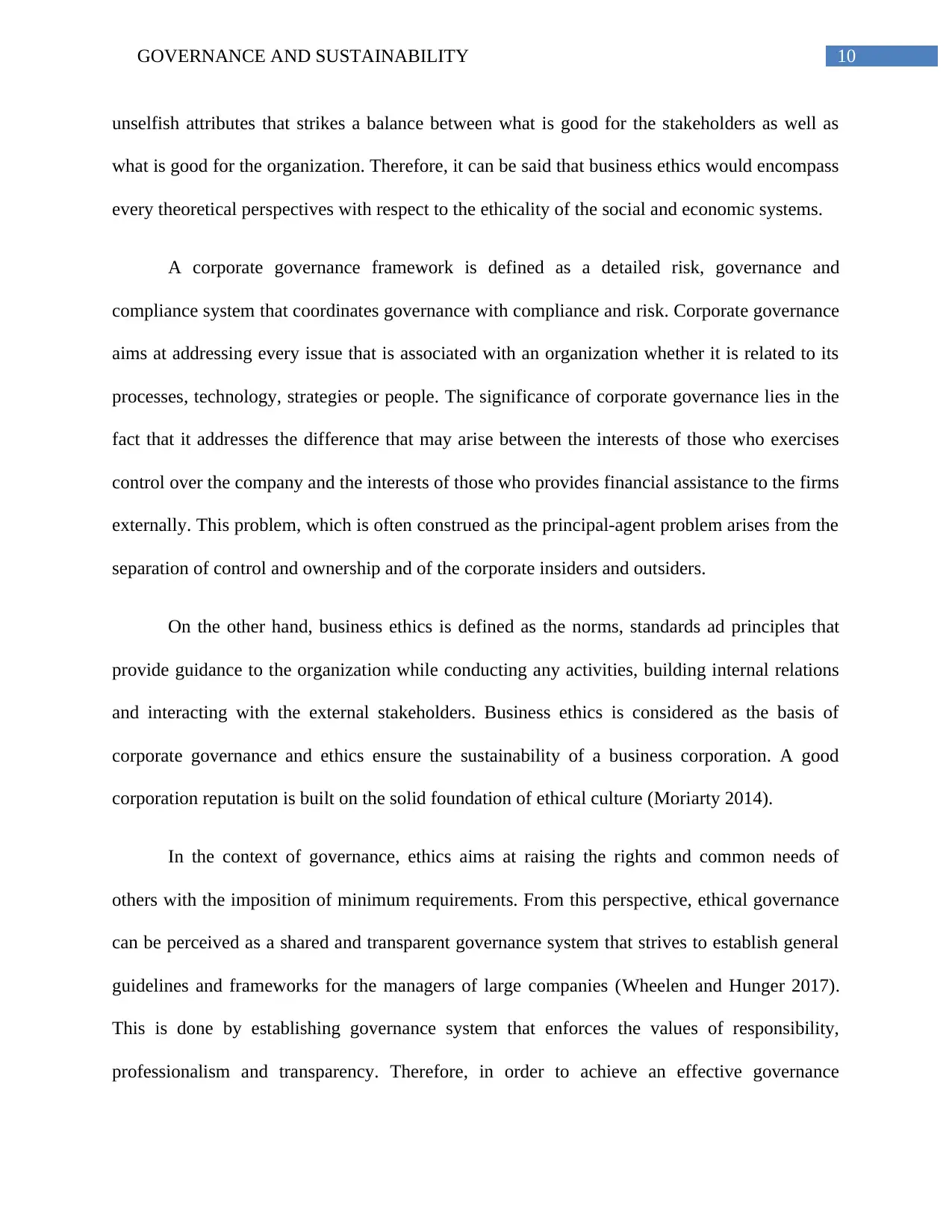
10GOVERNANCE AND SUSTAINABILITY
unselfish attributes that strikes a balance between what is good for the stakeholders as well as
what is good for the organization. Therefore, it can be said that business ethics would encompass
every theoretical perspectives with respect to the ethicality of the social and economic systems.
A corporate governance framework is defined as a detailed risk, governance and
compliance system that coordinates governance with compliance and risk. Corporate governance
aims at addressing every issue that is associated with an organization whether it is related to its
processes, technology, strategies or people. The significance of corporate governance lies in the
fact that it addresses the difference that may arise between the interests of those who exercises
control over the company and the interests of those who provides financial assistance to the firms
externally. This problem, which is often construed as the principal-agent problem arises from the
separation of control and ownership and of the corporate insiders and outsiders.
On the other hand, business ethics is defined as the norms, standards ad principles that
provide guidance to the organization while conducting any activities, building internal relations
and interacting with the external stakeholders. Business ethics is considered as the basis of
corporate governance and ethics ensure the sustainability of a business corporation. A good
corporation reputation is built on the solid foundation of ethical culture (Moriarty 2014).
In the context of governance, ethics aims at raising the rights and common needs of
others with the imposition of minimum requirements. From this perspective, ethical governance
can be perceived as a shared and transparent governance system that strives to establish general
guidelines and frameworks for the managers of large companies (Wheelen and Hunger 2017).
This is done by establishing governance system that enforces the values of responsibility,
professionalism and transparency. Therefore, in order to achieve an effective governance
unselfish attributes that strikes a balance between what is good for the stakeholders as well as
what is good for the organization. Therefore, it can be said that business ethics would encompass
every theoretical perspectives with respect to the ethicality of the social and economic systems.
A corporate governance framework is defined as a detailed risk, governance and
compliance system that coordinates governance with compliance and risk. Corporate governance
aims at addressing every issue that is associated with an organization whether it is related to its
processes, technology, strategies or people. The significance of corporate governance lies in the
fact that it addresses the difference that may arise between the interests of those who exercises
control over the company and the interests of those who provides financial assistance to the firms
externally. This problem, which is often construed as the principal-agent problem arises from the
separation of control and ownership and of the corporate insiders and outsiders.
On the other hand, business ethics is defined as the norms, standards ad principles that
provide guidance to the organization while conducting any activities, building internal relations
and interacting with the external stakeholders. Business ethics is considered as the basis of
corporate governance and ethics ensure the sustainability of a business corporation. A good
corporation reputation is built on the solid foundation of ethical culture (Moriarty 2014).
In the context of governance, ethics aims at raising the rights and common needs of
others with the imposition of minimum requirements. From this perspective, ethical governance
can be perceived as a shared and transparent governance system that strives to establish general
guidelines and frameworks for the managers of large companies (Wheelen and Hunger 2017).
This is done by establishing governance system that enforces the values of responsibility,
professionalism and transparency. Therefore, in order to achieve an effective governance
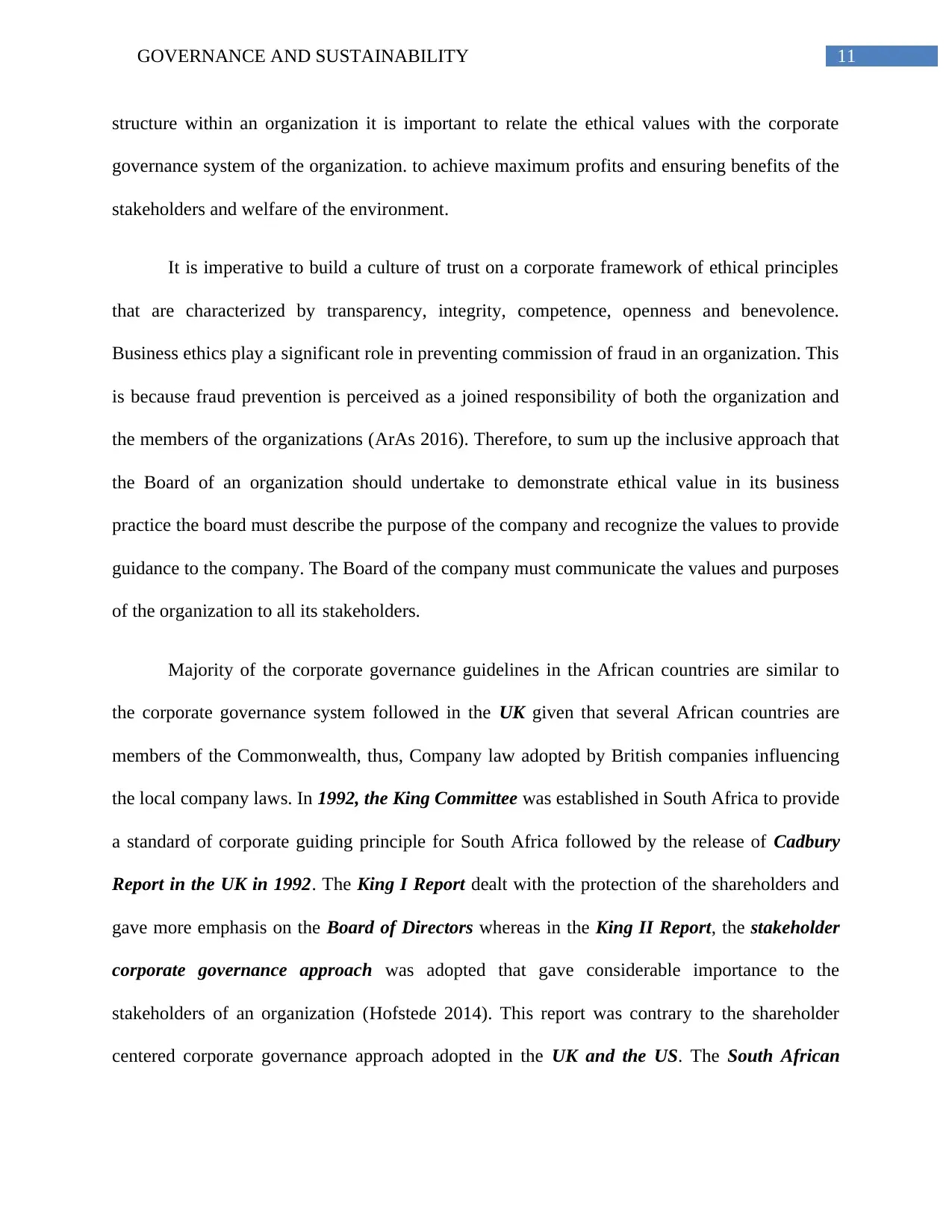
11GOVERNANCE AND SUSTAINABILITY
structure within an organization it is important to relate the ethical values with the corporate
governance system of the organization. to achieve maximum profits and ensuring benefits of the
stakeholders and welfare of the environment.
It is imperative to build a culture of trust on a corporate framework of ethical principles
that are characterized by transparency, integrity, competence, openness and benevolence.
Business ethics play a significant role in preventing commission of fraud in an organization. This
is because fraud prevention is perceived as a joined responsibility of both the organization and
the members of the organizations (ArAs 2016). Therefore, to sum up the inclusive approach that
the Board of an organization should undertake to demonstrate ethical value in its business
practice the board must describe the purpose of the company and recognize the values to provide
guidance to the company. The Board of the company must communicate the values and purposes
of the organization to all its stakeholders.
Majority of the corporate governance guidelines in the African countries are similar to
the corporate governance system followed in the UK given that several African countries are
members of the Commonwealth, thus, Company law adopted by British companies influencing
the local company laws. In 1992, the King Committee was established in South Africa to provide
a standard of corporate guiding principle for South Africa followed by the release of Cadbury
Report in the UK in 1992. The King I Report dealt with the protection of the shareholders and
gave more emphasis on the Board of Directors whereas in the King II Report, the stakeholder
corporate governance approach was adopted that gave considerable importance to the
stakeholders of an organization (Hofstede 2014). This report was contrary to the shareholder
centered corporate governance approach adopted in the UK and the US. The South African
structure within an organization it is important to relate the ethical values with the corporate
governance system of the organization. to achieve maximum profits and ensuring benefits of the
stakeholders and welfare of the environment.
It is imperative to build a culture of trust on a corporate framework of ethical principles
that are characterized by transparency, integrity, competence, openness and benevolence.
Business ethics play a significant role in preventing commission of fraud in an organization. This
is because fraud prevention is perceived as a joined responsibility of both the organization and
the members of the organizations (ArAs 2016). Therefore, to sum up the inclusive approach that
the Board of an organization should undertake to demonstrate ethical value in its business
practice the board must describe the purpose of the company and recognize the values to provide
guidance to the company. The Board of the company must communicate the values and purposes
of the organization to all its stakeholders.
Majority of the corporate governance guidelines in the African countries are similar to
the corporate governance system followed in the UK given that several African countries are
members of the Commonwealth, thus, Company law adopted by British companies influencing
the local company laws. In 1992, the King Committee was established in South Africa to provide
a standard of corporate guiding principle for South Africa followed by the release of Cadbury
Report in the UK in 1992. The King I Report dealt with the protection of the shareholders and
gave more emphasis on the Board of Directors whereas in the King II Report, the stakeholder
corporate governance approach was adopted that gave considerable importance to the
stakeholders of an organization (Hofstede 2014). This report was contrary to the shareholder
centered corporate governance approach adopted in the UK and the US. The South African
⊘ This is a preview!⊘
Do you want full access?
Subscribe today to unlock all pages.

Trusted by 1+ million students worldwide
1 out of 22
Related Documents
Your All-in-One AI-Powered Toolkit for Academic Success.
+13062052269
info@desklib.com
Available 24*7 on WhatsApp / Email
![[object Object]](/_next/static/media/star-bottom.7253800d.svg)
Unlock your academic potential
Copyright © 2020–2025 A2Z Services. All Rights Reserved. Developed and managed by ZUCOL.





